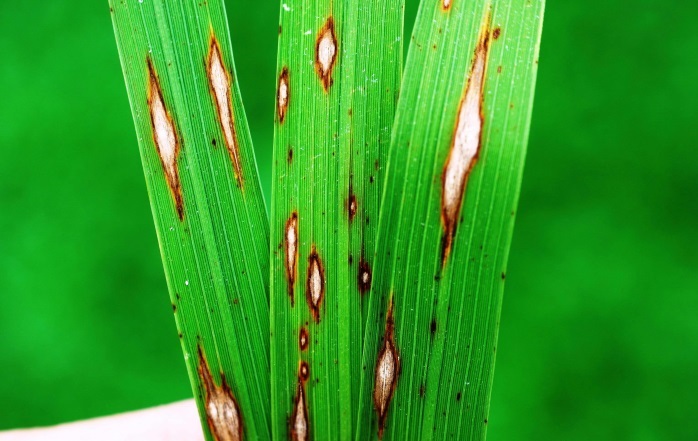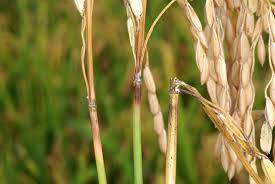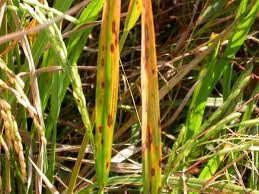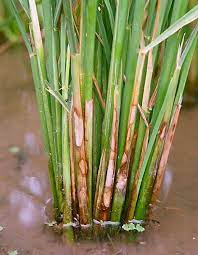
Major Rice Diseases: Guide for Healthy Crop
- By Agrosiaa Admin --
- Jul 19, 2022--
Hello Friends,
As we know that Paddy is the most important and extensively grown food crop in India. It is grown in almost all the states of India. Disease damage to rice can greatly reduce yield. They are mainly caused by bacteria, viruses, or fungi. An accurate diagnosis of plant disease is essential before selecting a management technique.Â
Here we are going to know about the major diseases of Rice crop. Definitely it helps you to manage your Rice field disease free.
Blast :Â
It is also known as rotten neck or rice fever disease.
Symptoms of damage
- Disease can infect paddy at all growth stages and all aerial parts of plant (Leaf, neck and node).
- Among the three leaves and neck infections are more severe.
- Small specks originate on leaves - subsequently enlarge into spindle shaped spots(0.5 to 1.5cm length, 0.3 to 0.5cm width) with ashy center.
- Several spots coalesce in big irregular patches

LEAF BLAST DISEASE OF RICE
1) Leaf Blast :
- The lesions appear as small bluish green flecks
- Spindle shaped spots with grey centre and dark brown margin.
- Severe cases of infection - entire crop give a blasted or burnt appearance- hence the name "BLAST.
 NECK BLAST DISEASE OF RICE
NECK BLAST DISEASE OF RICE
2) Neck Blast:
- Neck region of panicle develops a black color and shrivelsÂ
- Completely / partially grain set inhibited                  Â
- Panicle breaks at the neck and hangs
 NECK AND NODAL BLAST DISEASE OF RICEÂ
NECK AND NODAL BLAST DISEASE OF RICEÂ
3) Nodal Blast:Â
- Nodes become black and break up
Management
a. Cultural method
- Remove collateral weed hosts from bunds and channels
- Use only disease free seedlings
- Avoid excess nitrogen
- Apply N in three split doses (50% basal, 25% in tillering phase and 25% N in panicle initiation stage
b. Chemical Method
Spray below given fungicides after observing initial infection of the disease,
- Carbendazim 50WP @ 500g/ha (or)
- Tricyclozole 75 WP @ 500g/ha (or)
- Metominostrobin 20 SC @ 500ml/ha (or) 47
- Azoxystrobin 25 SC @ 500 ml/ha
 BACTERIAL LEAF BLIGHT DISEASE OF RICE
BACTERIAL LEAF BLIGHT DISEASE OF RICE
Bacterial Leaf Blight
Symptoms of Damage
- Seedling wilt or kresek
- Water-soaked to yellowish stripes on leaf blades or starting at leaf tips then later increase in length and width with a wavy margin
- Appearance of bacterial ooze that looks like a milky or opaque dewdrop on young lesions early in the morning
- Lesions turn yellow to white as the disease advances
- If the cuts end of leaf is kept in water it becomes turbid because of bacterial ooze"
ManagementÂ
- Spray fresh cowdung extract 20% twice (starting from initial appearance of the disease and another at fortnightly interval)
- Neem oil 60 EC 3% (or) NSKE 5% is recommended for the control of sheath rot, sheath blight, grain discolouration and bacterial blight"
- Spray with copper oxychloride 40 g and streptomycin sulphate * 5 g per 15 liters of water, three sprays at 15 days interval.
- Drain excess water from the field. The next dose of Nitrogen fertilizer should be given to the crop in small quantity.
 TUNGRO DISEASE OF RICE CROP
TUNGRO DISEASE OF RICE CROP
Rice tungro disease : Rice tungro virus (RTSV, RTBV)
Symptoms of Damage
- Plants affected by tungro exhibit stunting and reduced tillering.Â
- Their leaves become yellow or orange-yellow, may also have rust-colored spots.
- Discoloration begins from leaf tip and extends down to the blade or the lower leaf portion
- Delayed flowering, - panicles becomes small and not completely exerted
- Most panicles sterile or partially filled grains
Management
- Light traps are to be set up to attract and control the leaf hopper vectors as well as to monitor the population.
- In the early morning, the population of leafhopper alighting near the light trap should be killed by spraying/dusting the insecticides. This should be practiced every day.
- Spray Two rounds of either Thiamethoxam 25 WDG 100g/ha or Imidacloprid 17.8 SL 100ml/haat 15 and 30 days after transplanting.
- The vegetation on the bunds should also be sprayed with the insecticides.

BROWN SPOT DISEASE OF RICE
Brown Spot:
Symptoms of Damage
- Minute spots on the coleoptile, leaf blade, leaf sheath, and glume.               Â
- Spots become cylindrical or oval, dark brown with yellow halo.               Â
- Drying of leaves and nursery shows scorched appearance from a distance.      Â
- Dark brown or black spots also appear on glumes leading to grain discoloration.     Â
Management
- Field sanitation-removal of collateral hosts and infected debris from the field.
- Use of slow release nitrogenous fertilizers is advisable.
- Grow tolerant varieties viz., Co44 and Bhavani.
- Use disease free seeds.
- Treat the seeds with Thiram or Captan at 4 g/kg. Spray the nursery with Edifenphos 40 ml or Mancozeb 80 g.
- Spray the crop in the main field with Edifenphos 500 ml or Mancozeb 2 kg/ha and repeat after 15 days.
 SHEATH BLIGHT DISEASE OF RICE
SHEATH BLIGHT DISEASE OF RICE
Sheath Blight:Â
Symptoms of Damage
- The fungus affects the crop from tillering to heading stage.Â
- Initial symptoms are noticed on leaf sheaths near water level.Â
- On the leaf sheath oval or elliptical or irregular greenish grey spots are formed.Â
- As the spots enlarge, the centre becomes greyish white with an irregular blackish brown or purple brown border.
- Lesions on the upper parts of plants extend rapidly coalesing with each other to cover entire tillers from the water line to the flag leaf.Â
- The presence of several large lesions on a leaf sheath usually causes death of the whole leaf, and in severe cases all the leaves of a plant may be blighted.
Management
- Apply Neem cake at 150 kg/ha
- Foliar spray with Neem oil at 3% (15 lit /ha) starting from disease appearance
- Spray fungicides like Carbendazim 50 WP @ 500g/ha, Azoxystrobin @ 500ml/ha
Conclusions:
So friends, for healthy Rice crop we need to manage diseases properly. Hence I've compiled the following key takeaways from this blog::
- To prevent the Rice crop from disease, use disease-free healthy seeds for sowing.
- Keep farm weed-free and clean.
- Apply a balanced dose of fertilizers as per crop requirement and soil condition.
- Seed treatment should be done before the sowing and transplanting of crop.
- Use fungicides as per the recommended dose at the proper time.
Most Rice diseases can be managed to minimize losses. An integrated approach that uses all of these methods is the most effective and profitable.
I will also be writing on other important factor pests of rice crop that affect crop growth and its yield in my next article.
So stay tuned with your Farm Friend!
Ram Ram!











IMPORTANT LINKS
http://krishi.maharashtra.gov.in/Site/Upload/Pdf/PMFBY__2020_Gr_for_publication.pdf
http://krishi.maharashtra.gov.in/Site/Upload/Pdf/PMFBY_Process_Leaflet_Final_Print_File_15-10-2020.pdf